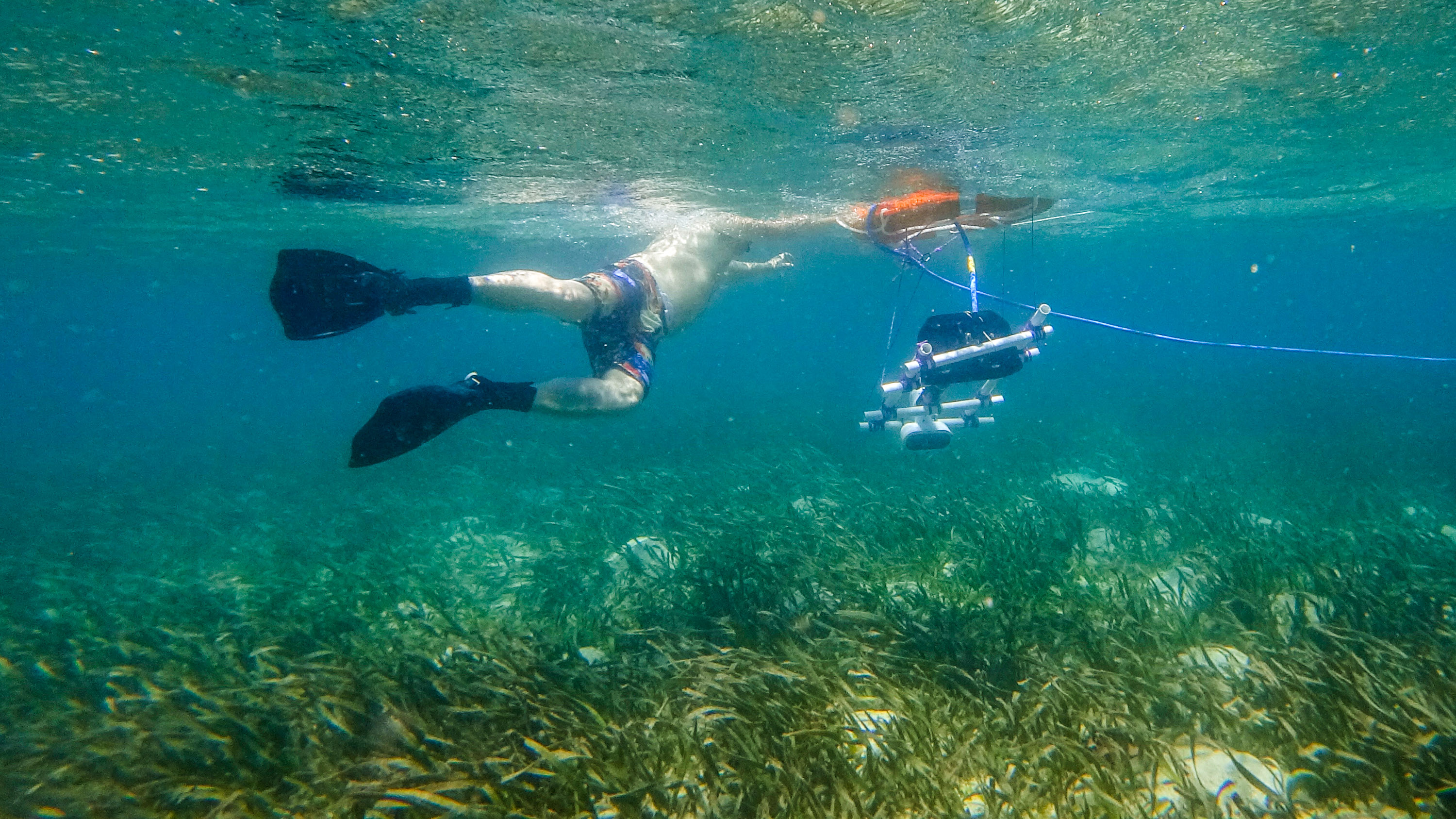 Terry Smith, a solutions engineer at Tidal, pulls an underwater camera system over a seagrass meadow near Manjerite Beach in Labuan Bajo, Indonesia.
Terry Smith, a solutions engineer at Tidal, pulls an underwater camera system over a seagrass meadow near Manjerite Beach in Labuan Bajo, Indonesia.photo : Agoes Rudianto
From Technology Review by James Temple
A previously unrevealed program would use cameras, computer vision, and machine learning to track the carbon stored in the biomass of the oceans.
In late September, Bianca Bahman snorkeled above a seagrass meadow off the western coast of Flores, a scorpion-shaped volcanic island in eastern Indonesia.
As she flutter-kicked over the green seabed, Bahman steered an underwater camera suspended on a pair of small pontoons.
The stereoscopic camera captures high-resolution footage from two slightly different angles, creating a three-dimensional map of the ribbon-shaped leaves sprouting from the seafloor.
Bahman is a project manager for Tidal, whose team wants to use these cameras, along with computer vision and machine learning, to get a better understanding of life beneath the oceans.
Tidal has used the same camera system to monitor fish in aquafarms off the coast of Norway for several years.
Now, MIT Technology Review can report, Tidal hopes its system can help preserve and restore the world’s seagrass beds, accelerating efforts to harness the oceans to suck up and store away far more carbon dioxide.
Tidal is a project within Alphabet’s X division, the so-called moonshot factory.
Its mission is to improve our understanding of underwater ecosystems in order to inform and incentivize efforts to protect the oceans amid mounting threats from pollution, overfishing, ocean acidification, and global warming.
Its tools “can unlock areas that are desperately needed in the ocean world,” Bahman says.
Studies suggest the oceans could pull down a sizable share of the billions of additional tons of carbon dioxide that may need to be scrubbed from the atmosphere each year to keep temperatures in check by midcentury.
But making that happen will require restoring coastal ecosystems, growing more seaweed, adding nutrients to stimulate plankton growth, or similar interventions.
Tidal decided to focus initially on seagrass because it’s a fast-growing plant that’s particularly effective at absorbing carbon dioxide from shallow waters.
These coastal meadows might be able to suck up much more if communities, companies, or nonprofits take steps to expand them.
But scientists have only a rudimentary understanding of how much carbon seagrass sequesters, and how big a role the plant plays in regulating the climate.
Without that knowledge and affordable ways to verify that restoration efforts actually store away more carbon, it will be tricky to track climate progress and build credible carbon credit marketplaces that would pay for such practices.
Tidal hopes to crack the problem by developing models and algorithms that translate the three-dimensional maps of seagrass it captures into reliable estimates of the carbon held below.
If it works, automated versions of Tidal’s data-harvesting technology could provide that missing verification tool.
This could help kick-start and lend credibility to marine-based carbon credit projects and markets, helping to restore ocean ecosystems and slow climate change.
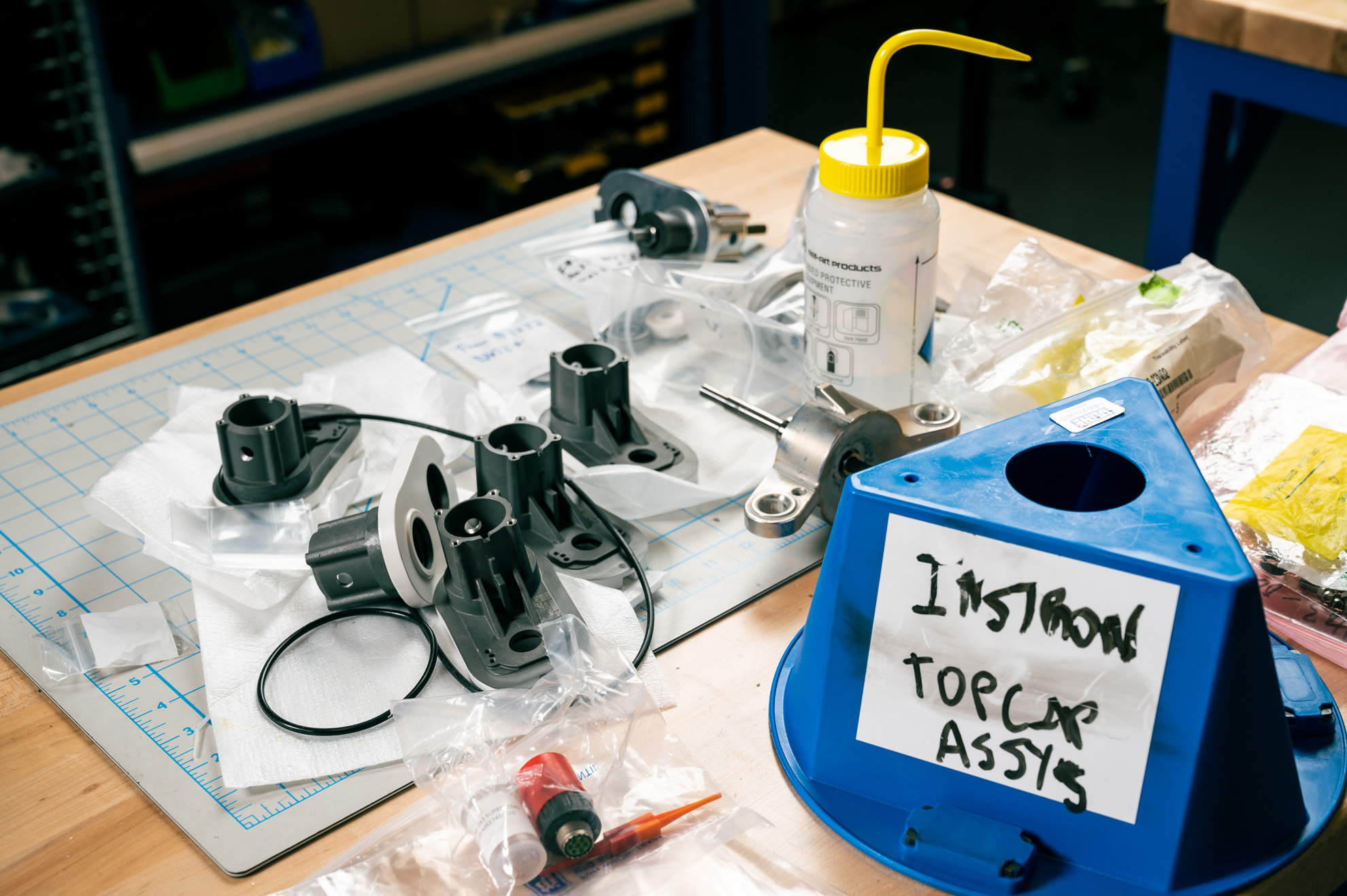
photo : Winni Wintermeyer
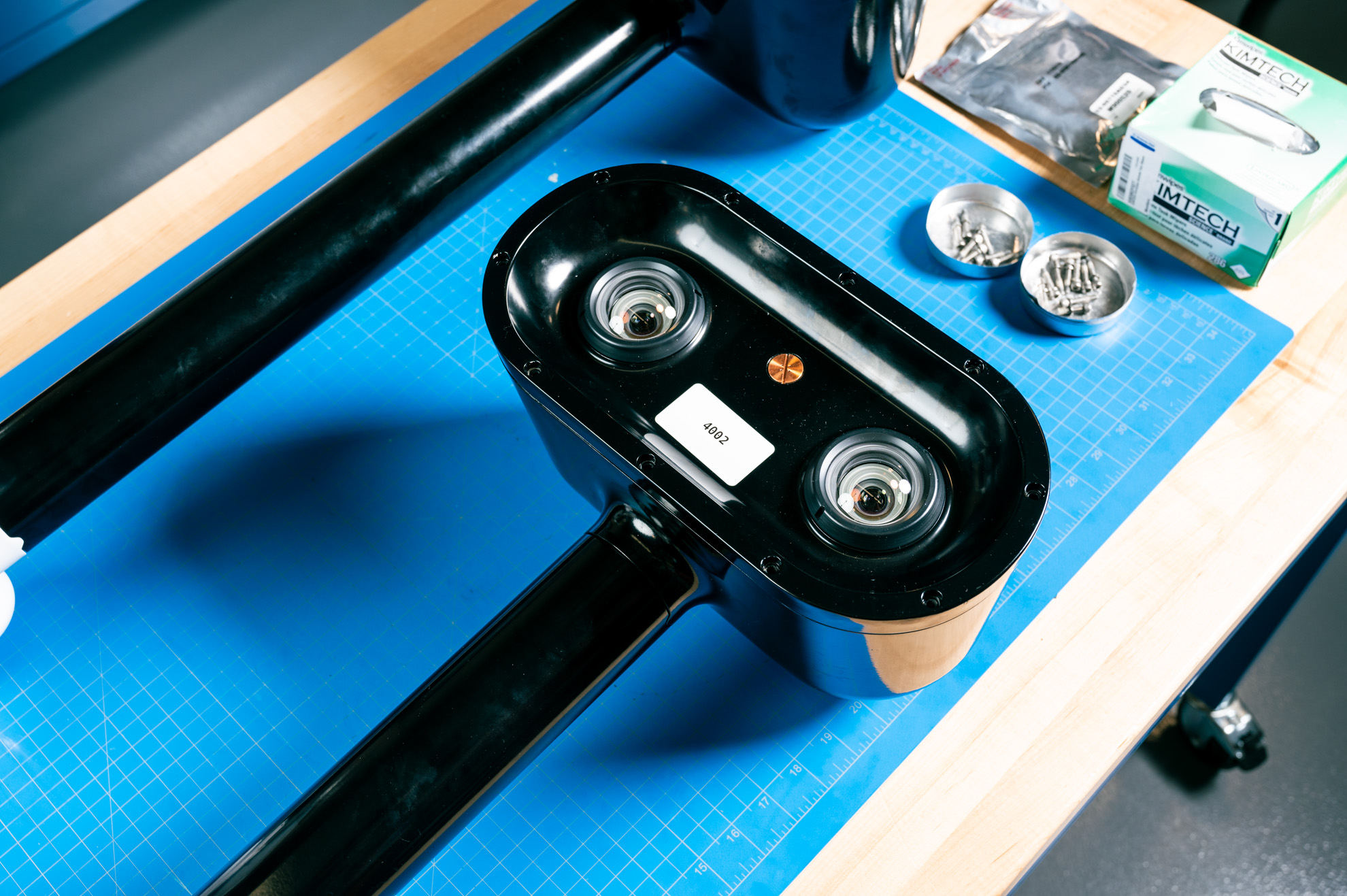
photo : Winni Wintermeyer
A workbench within X's building, where Tidal develops and tests its underwater camera systems.
The team envisions creating autonomous versions of its tools, possibly in the form of swimming robots equipped with its cameras, that can remotely monitor coastlines and estimate the growth or loss of biomass.
“If we can quantify and measure these systems, we can then drive investment to protect and conserve them,” says Neil Davé, the general manager of Tidal.
Still, some scientists are skeptical that Tidal’s technology will be able to accurately estimate shifting carbon levels in distant corners of the globe, among other challenges.
Indeed, nature-based carbon credits have faced growing criticism: studies and reporting find that such efforts can overestimate climate benefits, create environmental risks, or present environmental justice concerns.
Davé acknowledges that they don’t know how well it will work yet.
But he says that’s precisely what the Tidal team went to Indonesia, along with a group of Australian scientists, to try to find out.
X
Google launched what was then called Google X in early 2010, with a mandate to go after big, hard, even zany ideas that could produce the next Google.
This research division took over the self-driving-car project now known as Waymo.
It developed the Google Brain machine-learning tools that power YouTube recommendations, Google Translate, and numerous other core products of its parent company.
And it gave the world the Google Glassaugmented-reality headset (whether the world wanted it or not).
There were even short-lived flirtations with things like space elevators and teleportation.
X pursued climate-related projects from the start, but has had a very mixed track record in this area to date.
It acquired Makani, an effort to capture wind energy from large, looping kites, but the company shut down in 2020.
It also pursued a project to produce carbon-neutral fuels from seawater, dubbed Foghorn, but abandoned the effort after finding it’d be too hard to match the cost of gasoline.
The two official climate “graduates” still operating are Malta, a spinout that relies on molten salt to store energy for the grid in the form of heat, and Dandelion Energy, which taps into geothermal energy to heat and cool homes.
Both, however, remain relatively small and are still striving to gain traction in their respective markets.
After 12 years, X has yet to deliver a breakout success in climate or clean tech.
The question is whether shifting strategies at X, and the current crop of climate-related efforts like Tidal, will improve that track record.
Astro Teller, the head of X, told MIT Technology Review that the division “pushed hard on radical innovation” at first.
But it has since gradually turned up the “rigor dials” in lots of ways, he says, focusing more on the feasibility of the ideas it pursued.
The earlier X climate efforts were generally high-risk, hardware-heavy projects that directly addressed energy technologies and climate emissions, producing electricity, fuels, and storage in novel ways.
There are some clear differences in the climate projects that X is publicly known to be pursuing now.
The two aside from Tidal are Mineral, which is using solar-panel-equipped robots and machine learning to improve agricultural practices, and Tapestry, which is developing ways to simulate, predict, and optimize the management of electricity grids.
With Tidal, Mineral, and Tapestry, X is creating tools to ensure that industries can do more to address environmental dangers and that ecosystems can survive in a hotter, harsher world.
It’s also leaning heavily in to its parent company’s areas of strength, drawing on Alphabet’s robotics expertise as well as its ability to derive insights from massive amounts of data using artificial intelligence.
Such efforts might seem less transformative than, say, flying wind turbines—less moonshot, more enabling technology.
But while Teller allows that their new thinking may “be changing the character of the things that you see at X today,” he pushes back against the suggestion that the problems it’s pursuing aren’t as hard, big, or important as in the past.
“I don’t know that Tidal has to apologize for some sort of scope problem,” he says.
“Humanity needs the oceans and is killing off the oceans,” he adds.
“We have to find a way to get more value from the ocean for humanity, while simultaneously regenerating the oceans instead of continuing to deplete them.
And that’s just not going to happen unless we find a way to get automation into the oceans.”
A better protein source
Tidal, founded in 2018, grew out of informal conversations at X about the mounting threats to the oceans and the lack of knowledge required to address them, Davé says.
“The goal was overly simplistic: save the oceans, save the world,” he says.
“But it was based on the understanding that the oceans are critical to humanity, but probably the most neglected or misused resource we have.”
They decided to begin by focusing on a single application: aquaculture, which relies on land-based tanks, sheltered bays, or open ocean pens to raise fish, shellfish, seaweed, and more.
Today, these practices produce just over half the fish consumed by humans.
But the more they’re used, the more they might ease the commercial pressures to overfish, the emissions from fishing fleets, and the environmental impact of trawling.
Tidal believed it could provide tools that would allow aquafarmers to monitor their fish in a more affordable way, spot signs of problems earlier, and optimize their processes to ensure better health and faster growth, at lower cost.
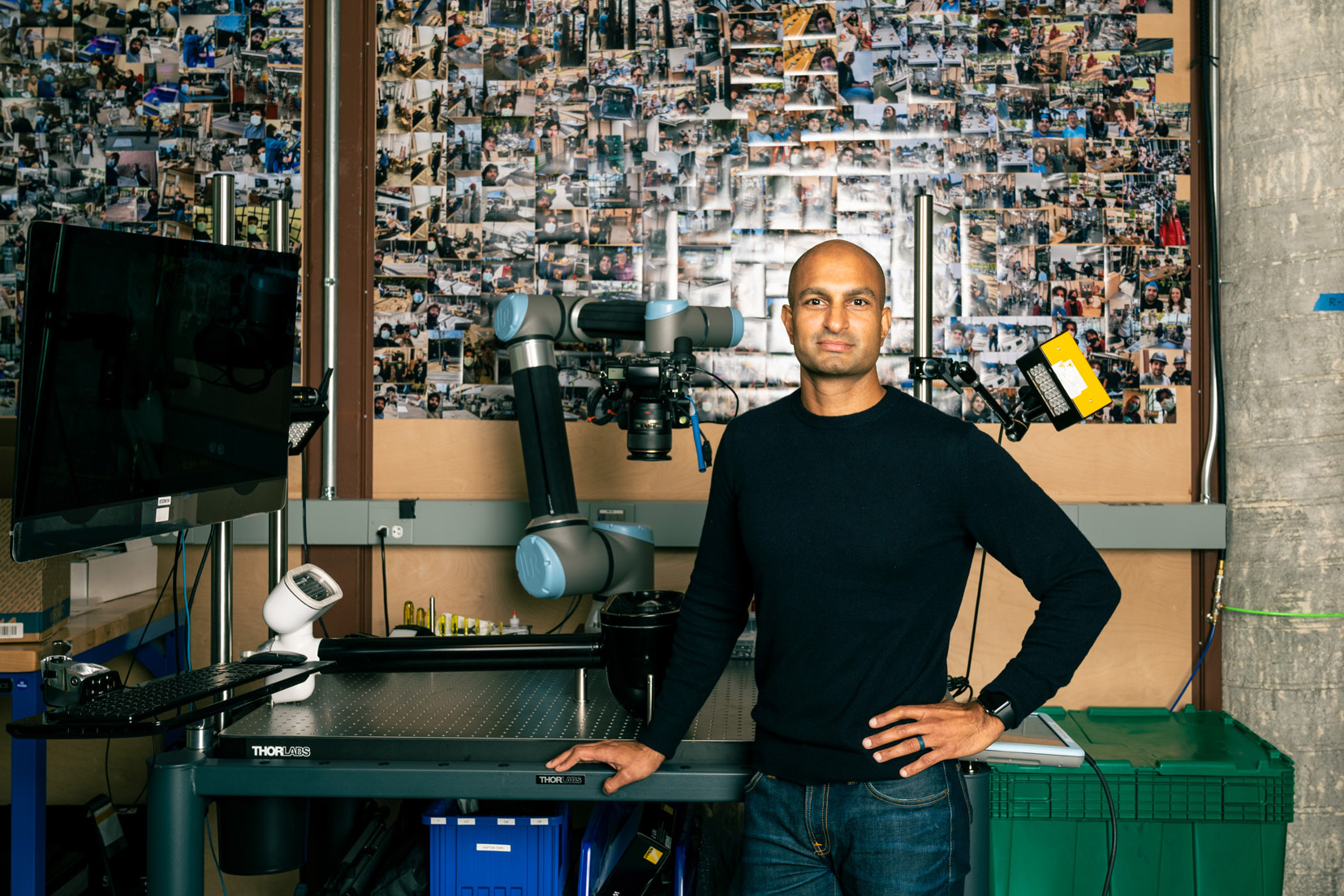
Neil Davé, the general manager of Tidal at X.
photo : Winni Wintermeyer
photo : Winni Wintermeyer
The researchers developed and tested a variety of prototypes for underwater camera systems.
They also began training computer vision software, which can identify objects and attributes within footage.
To get it started, they used goldfish in a kiddie pool.
For the last five years, they’ve been stress-testing their tools in the harsh conditions of the North Sea, through a partnership with the Norwegian seafood company Mowi.
During a Zoom call, Davé pulled up a black-and-white video of the chaos that ensues at feeding time, when salmon compete to gobble up the food dropped into the pen.
It’s impossible for the naked eye to draw much meaning from the scene.
But the computer vision software tags each fish with tiny colored boxes as it identifies individuals swimming through the frame, or captures them opening their mouths to feed.
Davé says fish farms can use that data in real time, even in an automated way.
For instance, they might stop dropping food into the pen when the fish cease feeding.
The cameras and software can perceive other important information as well, including how much the fish weigh, whether they have reached sexual maturity, and whether they show any signs of health problems.
They can detect spinal deformities, bacterial infections, and the presence of parasites known as sea lice, which are often too tiny for the human eye to see.
“We knew from the early days that aquaculture would be us getting our feet wet, so to speak,” says Grace Young, Tidal’s scientific lead.
“We knew it would be a stepping stone into working on other hard problems.”
Confident that it’s created one viable commercial application, Tidal is now turning its attention to gathering information about natural ocean ecosystems.
“Now is a big moment for us,” she adds, “because we’re able to see how the tools that we built can apply and make a difference in other ocean industries.”
Restoring our coasts
Seagrasses form thick meadows that can run thousands of miles along shallow coastlines, covering up to about 0.2% of the world’s ocean floors.
They provide nutrients and habitat to marine populations, filter pollution, and protectcoastlines.
The plants are photosynthetic, producing the food they need from sunlight, water, and carbon dioxide dissolved in ocean waters.
They store carbon in their biomass and deliver it into the seabed sediments.
They also help capture and bury the carbon in other organic matter that floats past.
Globally, seagrass beds may sequester as much as 8.5 billion tons of organic carbon in seafloor sediments and, to a much, much smaller degree, in their biomass.
On the high end, these meadows draw down and store away about 110 million additional tons each year.
But estimates of the total range and carbon uptake rates of seagrass vary widely.
A key reason is that there is no cheap and easy way to map the planet’s extensive coastlines.
Only about 60% of seagrass meadows have been surveyed in US waters, with “varying degrees of accuracy because of difficulties in remote sensing of underwater habitat,” according to a National Academies study.
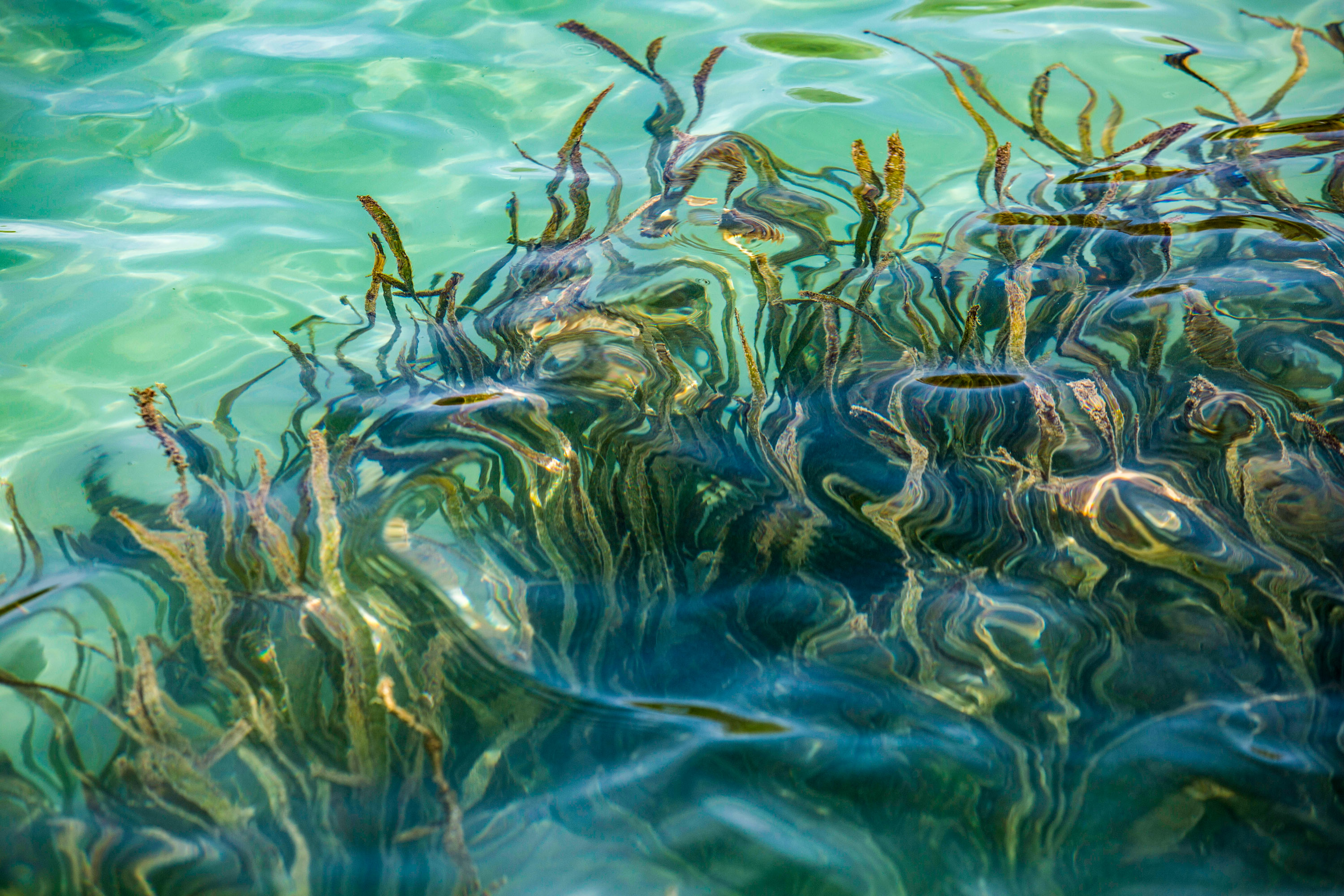
The seagrass meadows along Waecicu Beach in Labuan Bajo, Indonesia.
photo : Agoes Rudianto
photo : Agoes Rudianto
Whatever their full expanse, though, we know they are shrinking.
Development, overfishing, and pollution are all destroying coastal ecosystems, which also include carbon-sucking habitats like mangrove forests and salt marshes.
Draining and excavating these shallow biological communities releases hundreds of millions of tons of carbon dioxide each year.
Meanwhile, climate change itself is making ocean waters warmer, more acidic, and deeper, placing greater strains on many of the species.
Nations could help halt or reverse these trends by converting developed shorelines back into natural ones, actively managing and restoring wetlands and seagrass meadows, or planting them in new areas where they may do better as ocean levels rise.
Such work, however, would be wildly expensive.
The question is who would pay for it, particularly if it comes at the expense of lucrative coastal development.
The main possibility is that companies or governments could create market incentives to support preservation and restoration by awarding credits for the additional carbon that seagrass, mangroves, and salt marshes take up and store away.
Tens of billions of dollars’ worth of carbon credits are likely to be traded in voluntary markets in the coming decades, by some estimates.
The carbon market registry Verra has already developed a methodology for calculating the carbon credits earned through such work.
At least one seagrass project has applied to earn credits: a long-running effort by the Nature Conservancy’s Virginia chapter to plant eelgrass around the Virginia Barrier Islands.
But some marine scientists and carbon market experts argue that there need to be more rigorous ways to ensure that these efforts are removing as much carbon as they claim.
Otherwise, we risk allowing people or businesses to buy and sell carbon credits without meaningfully helping the climate.
Diving in
Tidal began exploring whether its tools could be used for seagrass late last year, as a growing body of studies underscored the need for carbon removal and highlighted the potential role of ocean-based approaches.
“We started to double-click and read a lot of studies,” Davé says.
“And found out, ‘Wow, we do have some technology we’ve developed that could be applicable here.’”
The team eventually held a series of conversations with researchers at the Commonwealth Scientific and Industrial Research Organisation (CSIRO), an Australian government science agency that has long used drones, satellites, acoustic positioning systems, and other equipment to survey coral reefs, mangrove forests, and seagrass meadows across the Indo-Pacific.
Seagrass is particularly difficult to map on large scales because in satellite images it’s difficult to distinguish from other dark spots in shallow waters, says Andy Steven, a marine scientist who oversees coastal research efforts at CSIRO.
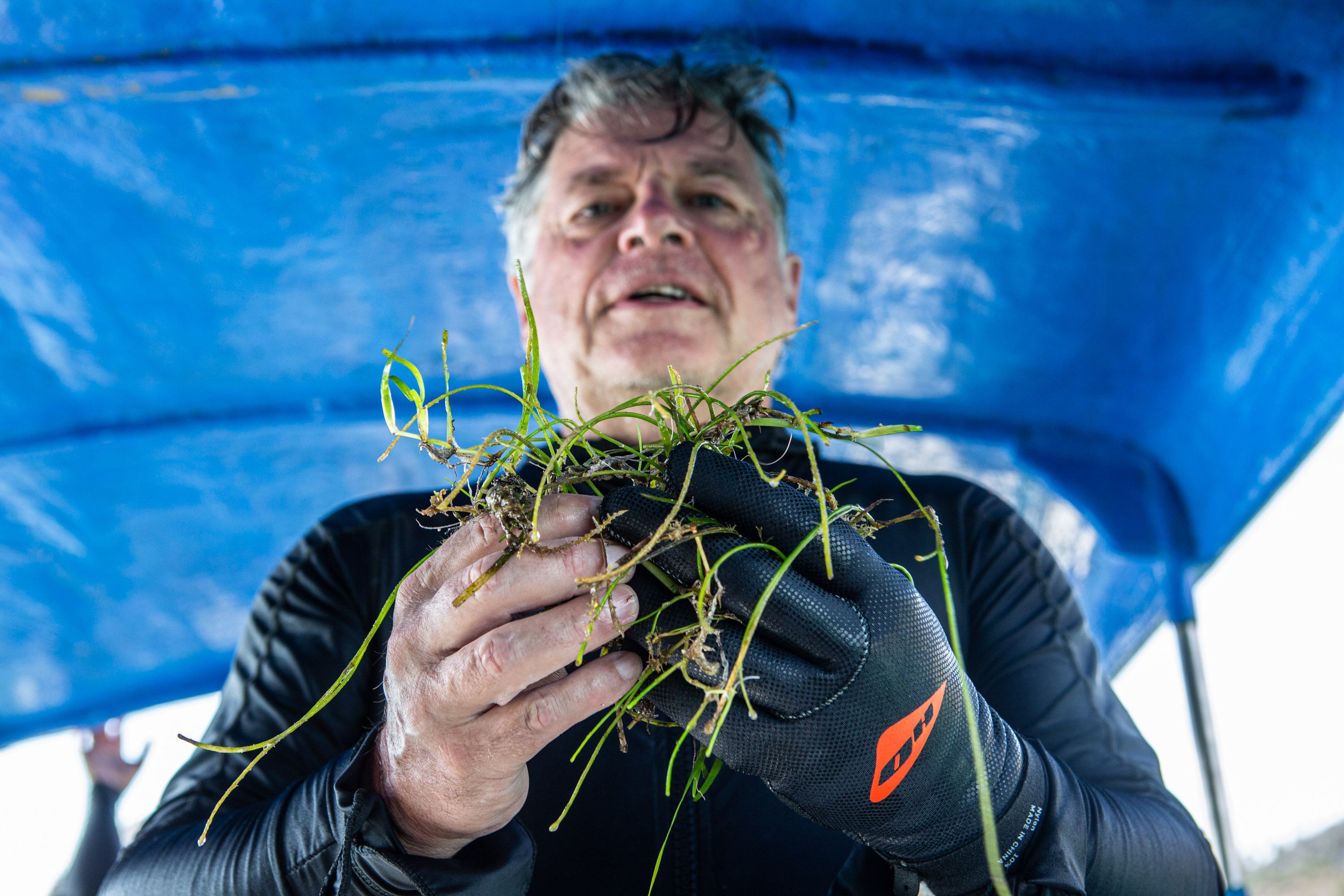 Andy Steven, a marine scientist with Australia's Commonwealth Scientific and Industrial Research Organisation, shows a seagrass sample excavated from meadows along Labuan Bajo, Indonesia.
Andy Steven, a marine scientist with Australia's Commonwealth Scientific and Industrial Research Organisation, shows a seagrass sample excavated from meadows along Labuan Bajo, Indonesia. photo : Agoes Rudianto
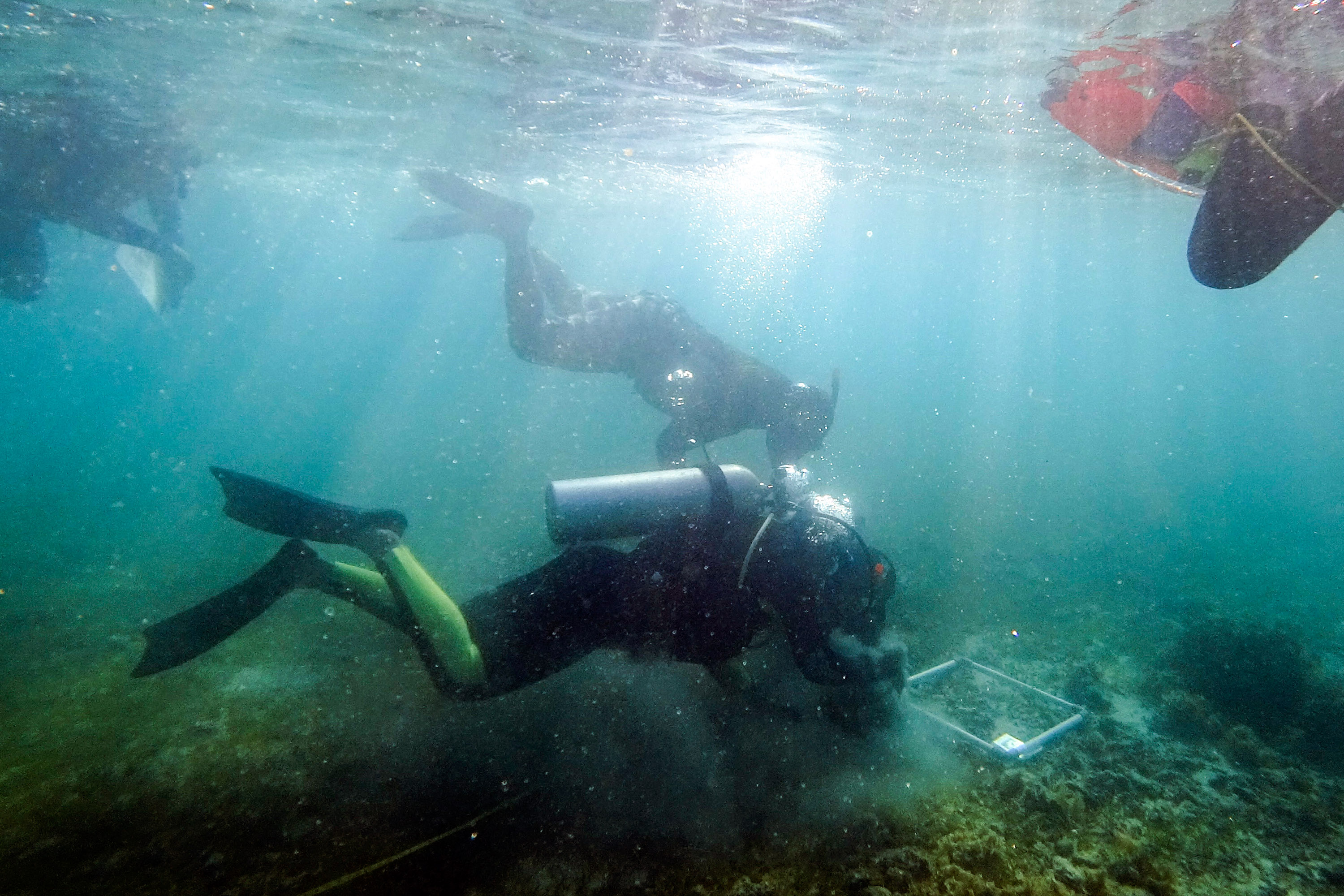
photo : Agoes Rudianto
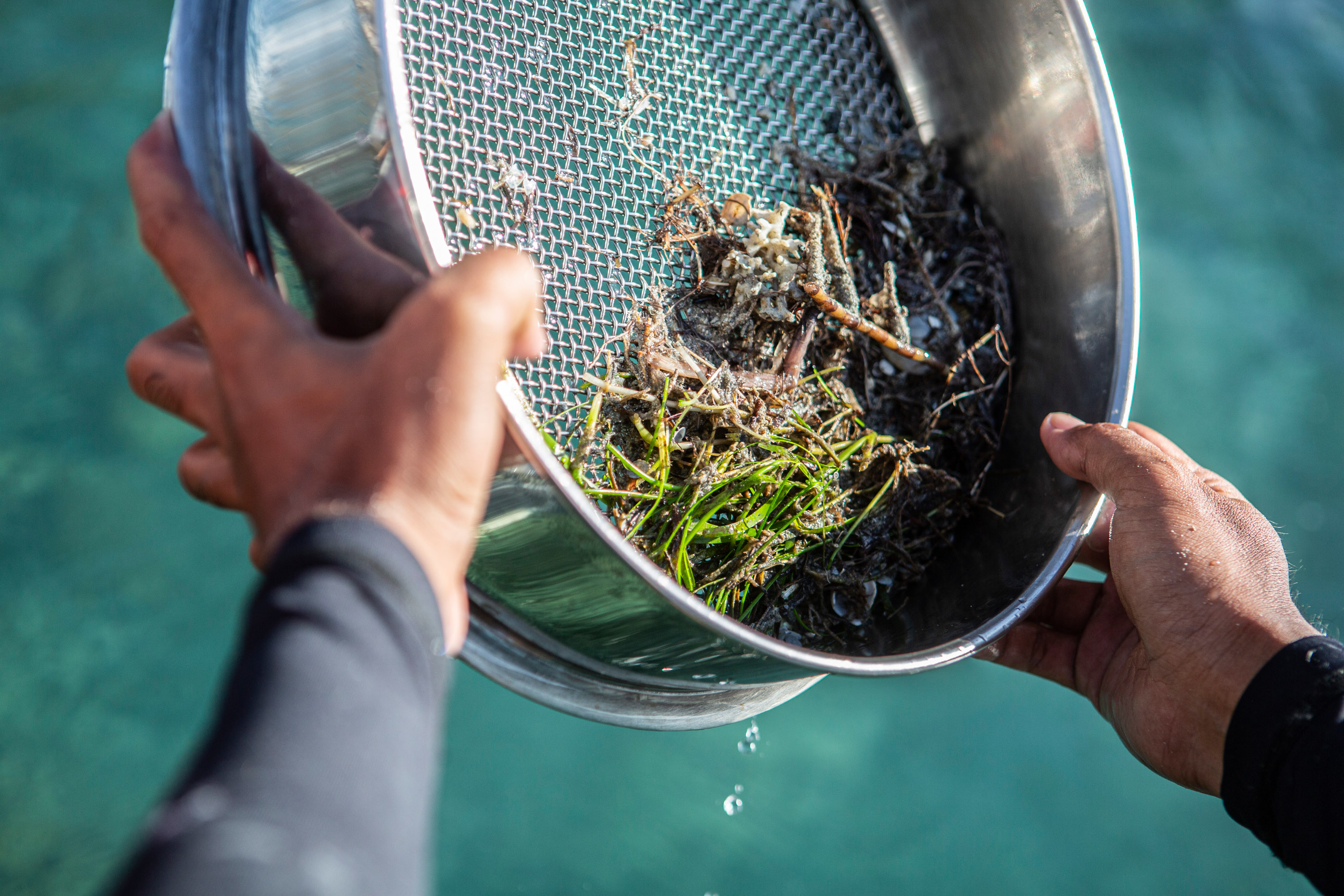
photo : Agoes Rudianto
Researchers with the Commonwealth Scientific and Industrial Research Organisation pull up and examine seagrass and sediments from research plots.
“The world needs to move to being able to map and then measure change on a far more frequent basis,” Steven says.
“I see the Tidal technology being part of an arsenal of methods that help us rapidly survey, process, and deliver information to decision makers on the time frames that are needed.
It is addressing a really fundamental issue.”
CSIRO agreed to help Tidal test how well its system works.
They collaborated on an earlier field trial off the coast of Fiji this summer and on the subsequent experiment this September in Indonesia.
The latter country's thousands of islands boast one of the world’s largest and most diverse expanses of seagrass meadows.
For the first effort, Tidal opted to couple its software with an off-the-shelf autonomous underwater vehicle equipped with a basic camera.
The hope was that if the researchers could scan meadows using standard hardware, their general approach would be more widely accessible.
It didn’t work.
The seagrass was taller and the tides were lower than expected.
The thruster and rudder quickly got clogged up with seaweed, forcing the team to stop every few minutes, Bahman says.
After a brainstorming whiteboard session, the Tidal team decided to take its own camera system, turn it face down, and put it on a float that could be pulled along by a boat.
The so-called Hammersled is equipped with fins to keep it moving straight and a set of ropes and cleats that allow the researchers to dip the camera deeper into the water.
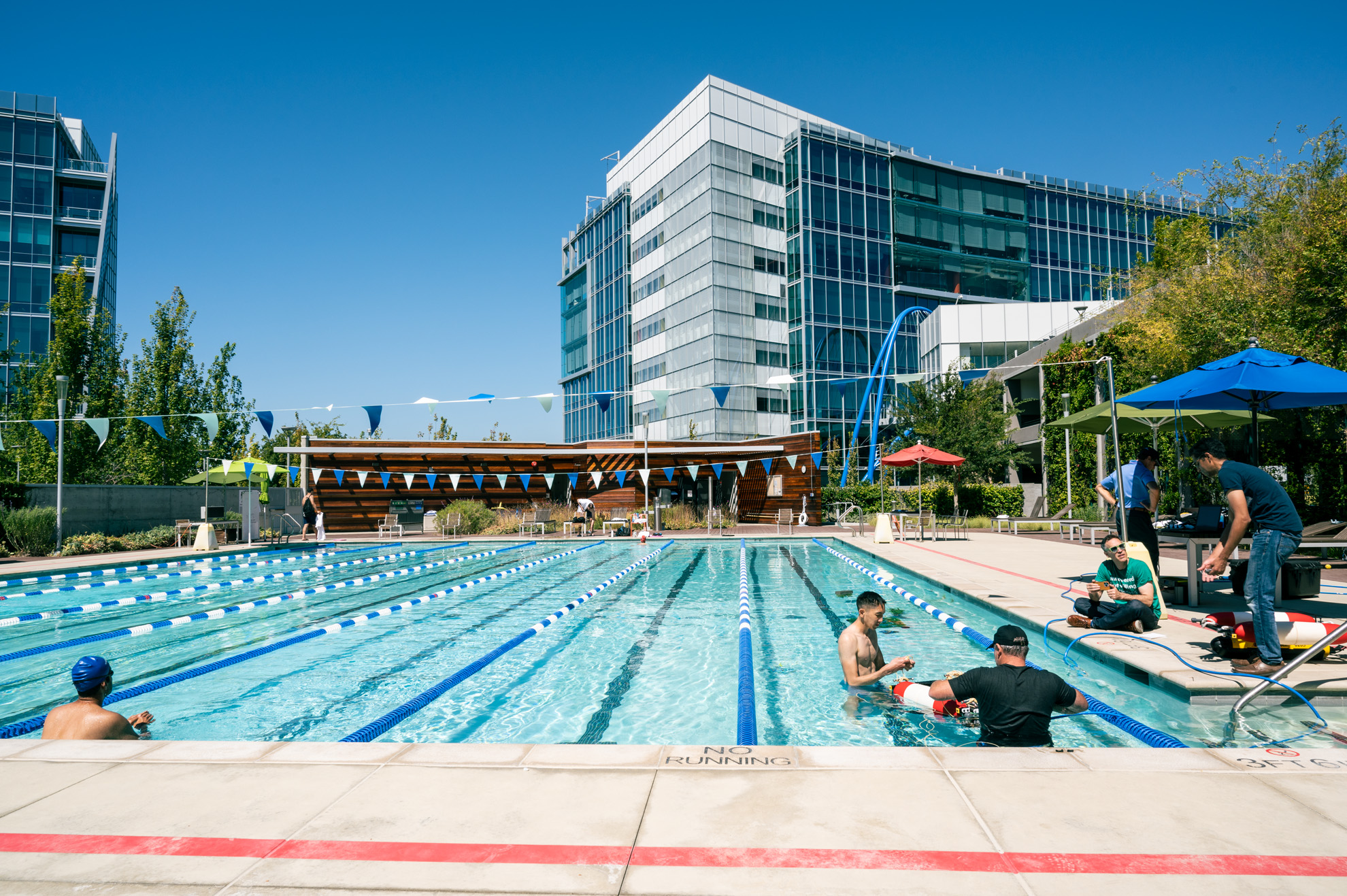
photo : Winni Wintermeyer
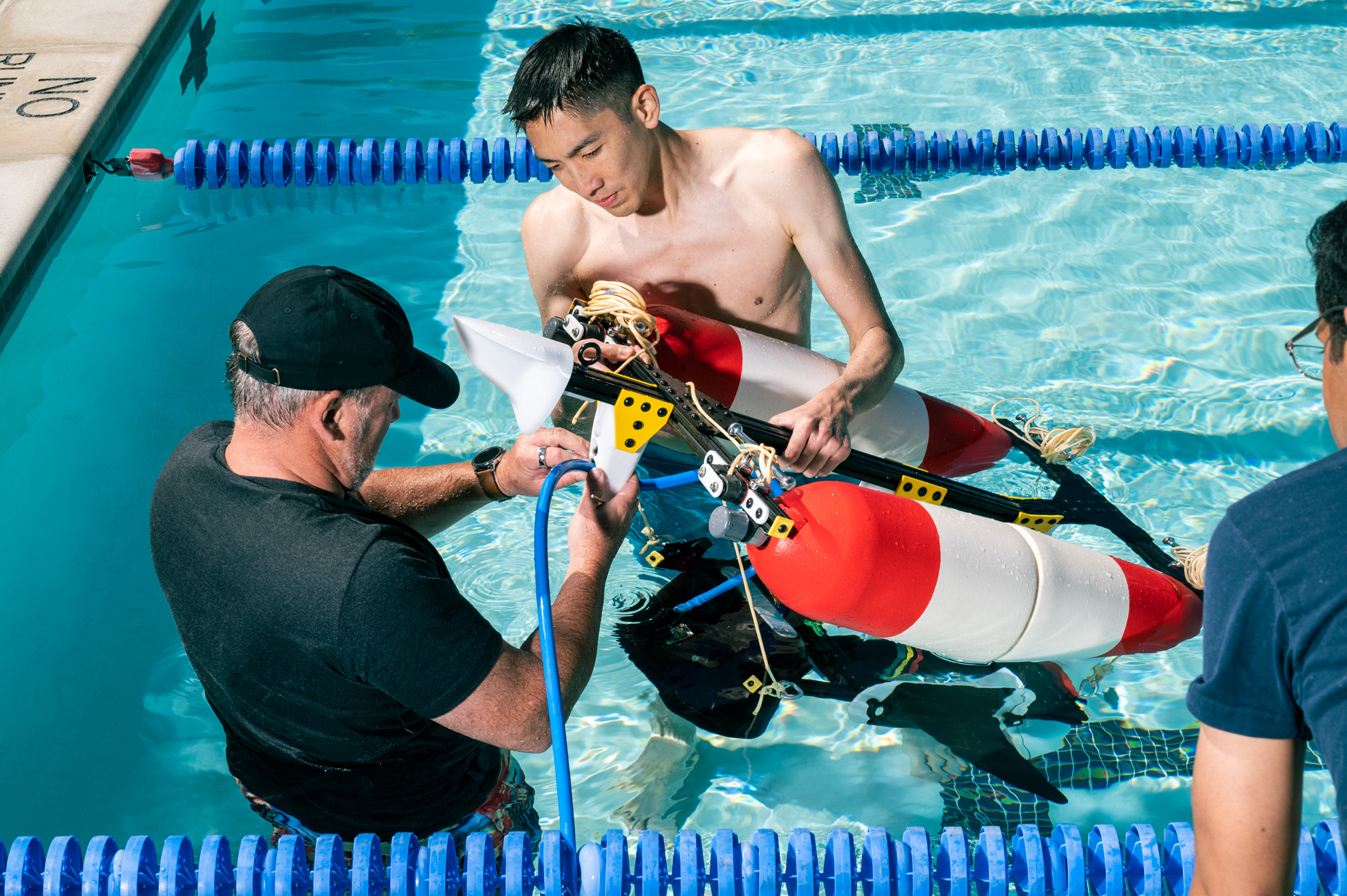
photo : Winni Wintermeyer
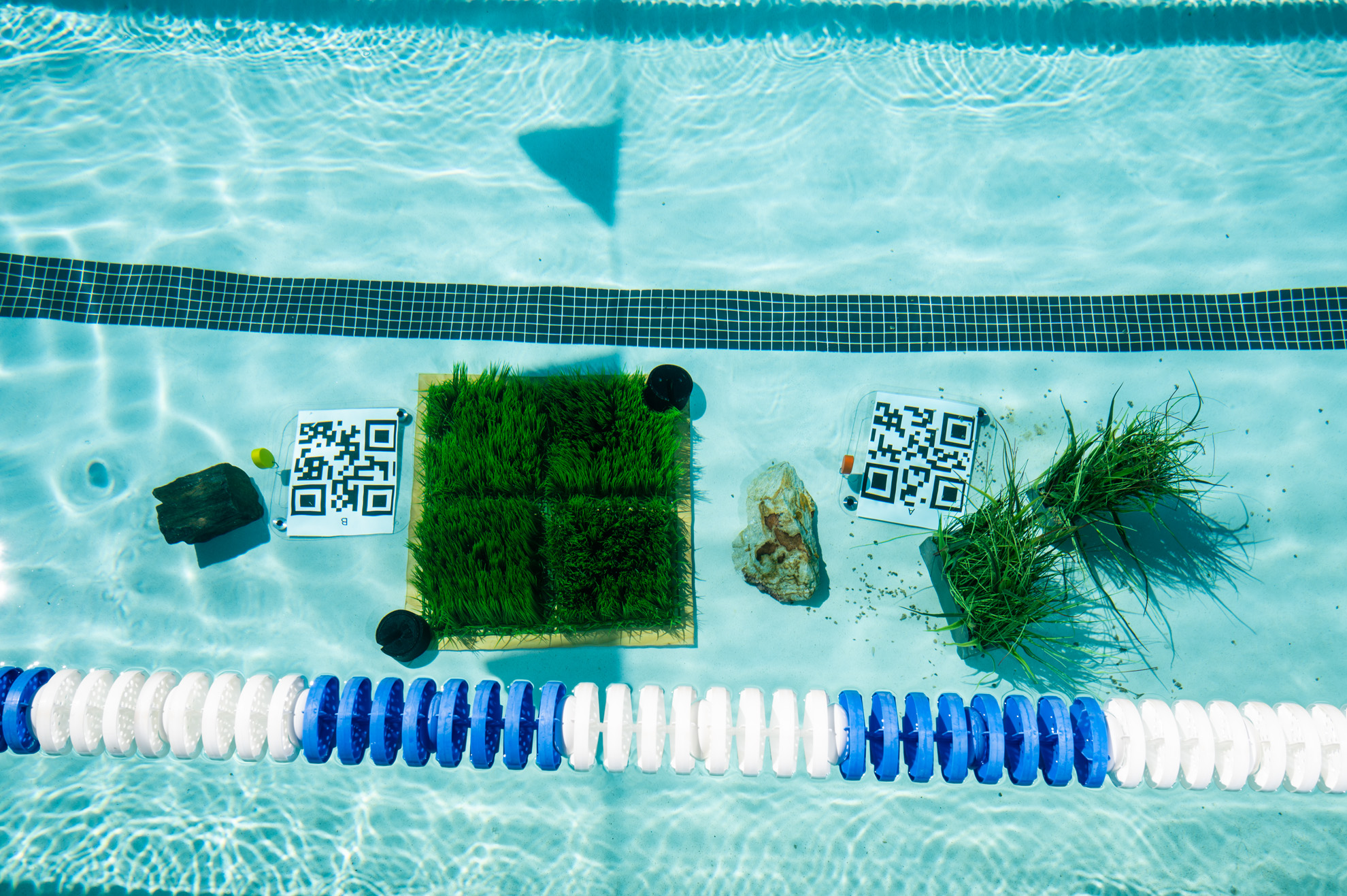
WINNI WINTERMEYER
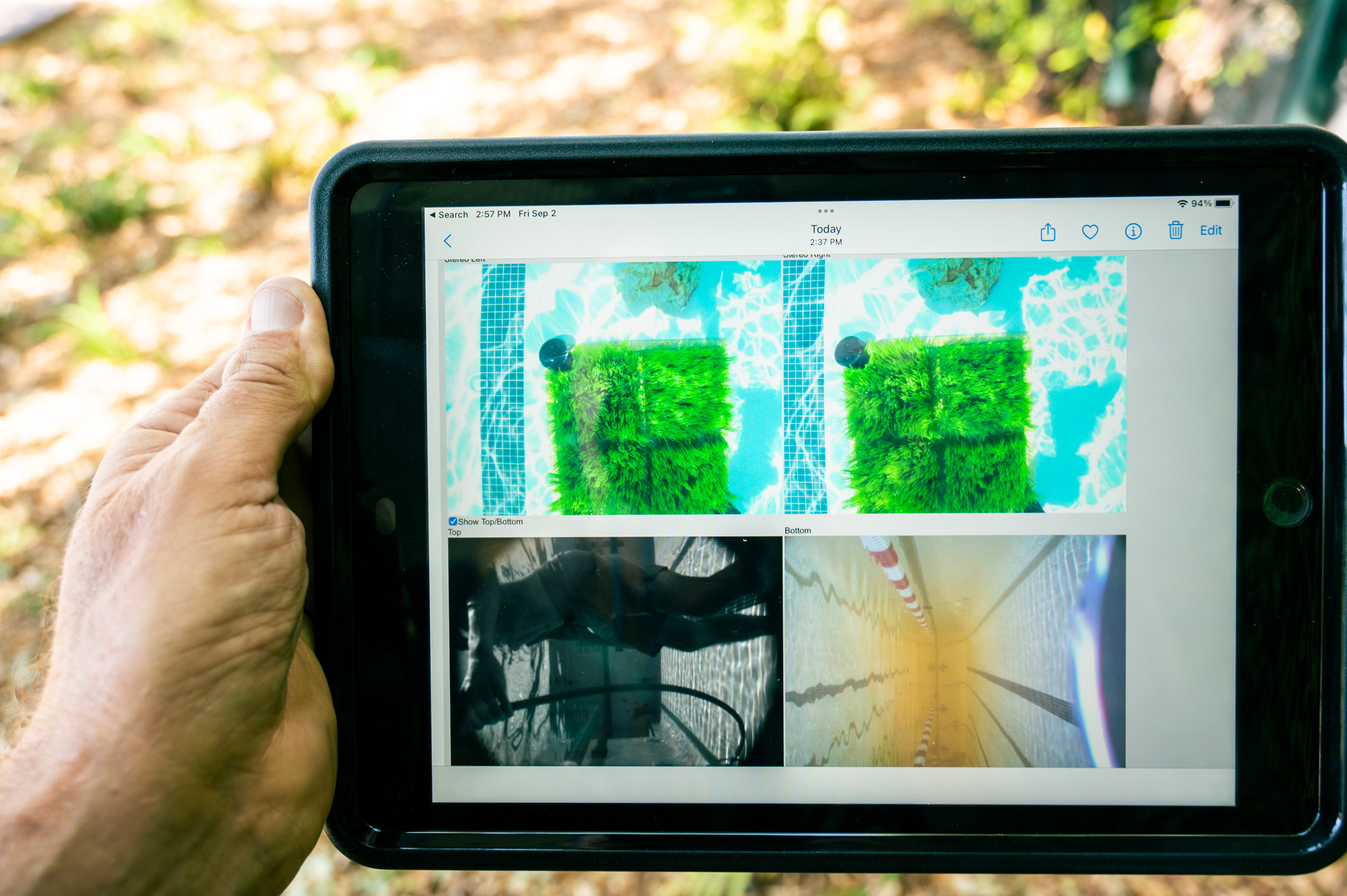
photo : Winni Wintermeyer
Tidal's researchers test out the "Hammersled" at a pool in the middle of Alphabet’s campus in Sunnyvale, California, by pulling it over patches of plastic seagrass.
The system worked well enough during a few tests in a large pool in the middle of Alphabet’s campus in Sunnyvale, California, where team members pulled it by hand over patches of plastic seagrass on the bottom.
The bigger test, however, is whether Tidal can translate its maps into an accurate estimate of the carbon seagrass holds and buries in the seafloor.
‘We’ve got it’
After Steven and his colleagues arrived in Labuan Bajo, on the western tip of Flores, they rented a 14-cabin liveaboard, the Sea Safari VII, and began sailing around the islands.
They launched surveillance drones from the deck to search for promising seagrass beds to study, prioritizing sites with many different species to help train Tidal’s models and algorithms for the wide variability that occurs in the natural world.
Once the CSIRO researchers selected, measured, tagged, filmed, and photographed their 100-meter transects, the Tidal team passed through.
They used a little Indonesian fishing boat to pull along the Hammersled.
Bahman, software engineer Hector Yee, and other staffers took turns jumping into the water with goggles and flippers to clasp a pontoon and keep the camera pointed straight as they crisscrossed the test area.
Once the process was complete, the CSIRO researchers used spades, peat borers, and other tools to pull up the seagrass and deep sediments from one-meter square study plots.
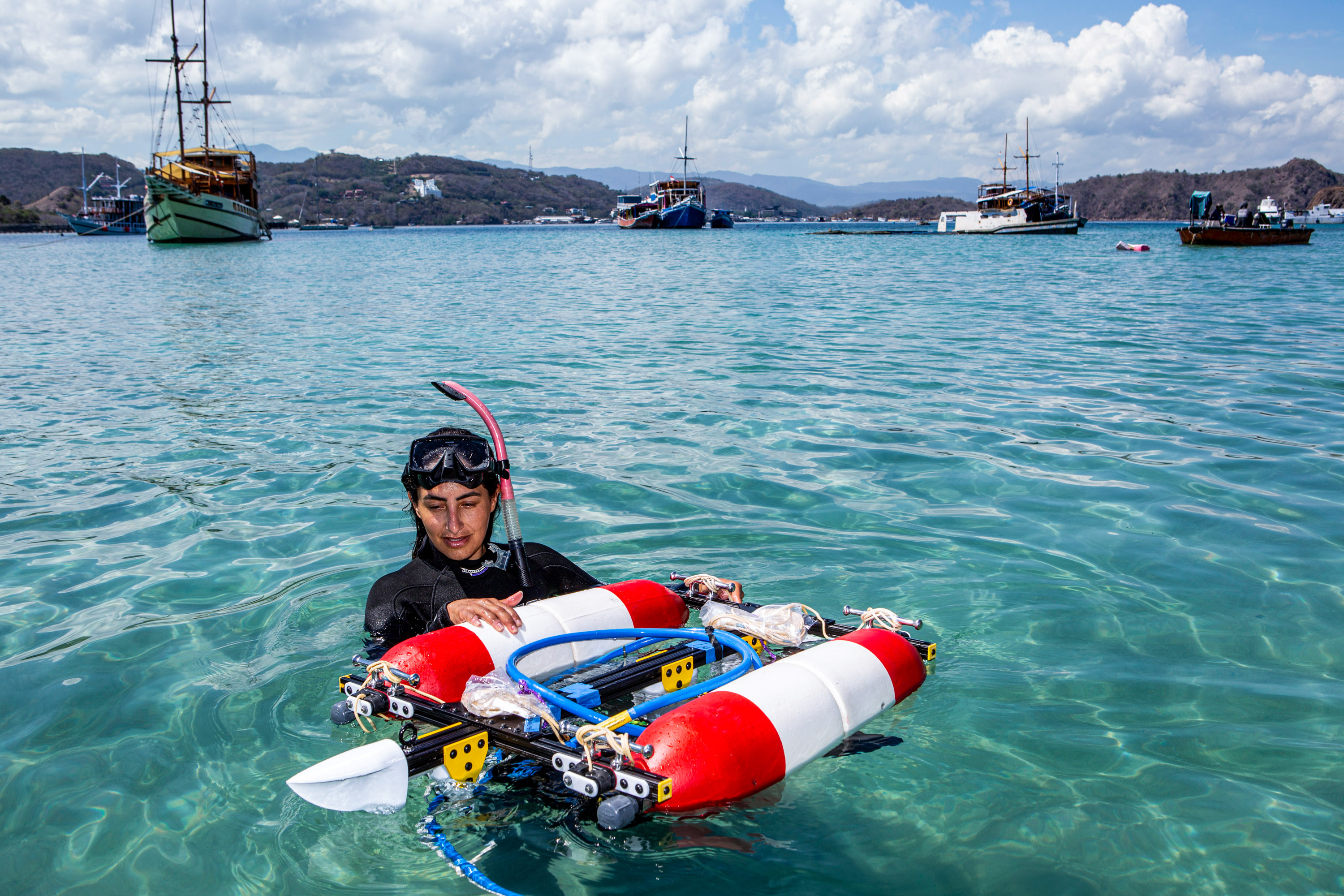 Bianca Bahman, a product manager at Tidal, steers the camera system over seagrass.
Bianca Bahman, a product manager at Tidal, steers the camera system over seagrass. photo : Agoes Rudianto
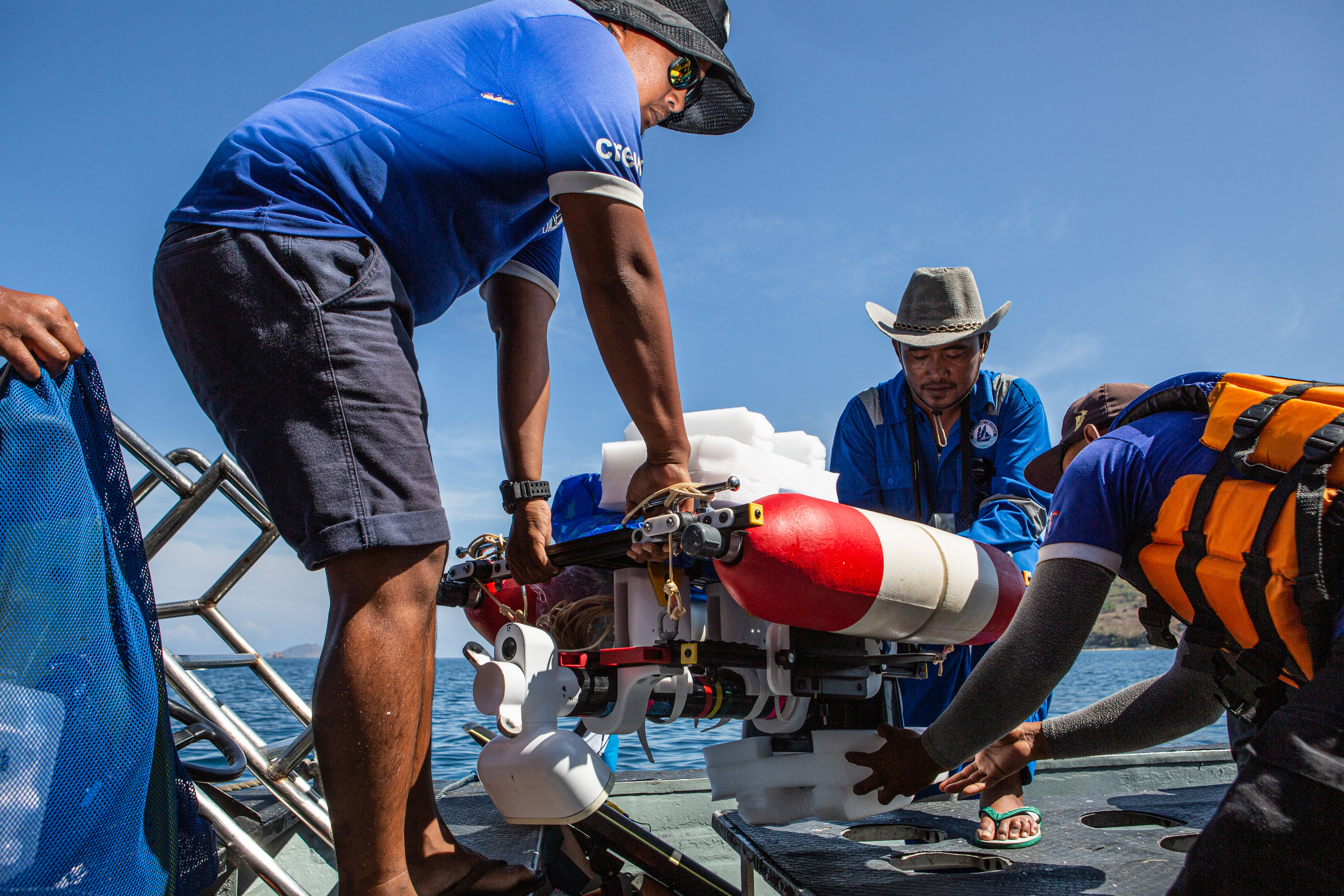
The Sea Safari crew helps the Tidal team load the camera system onto a boat.
photo : Agoes Rudianto
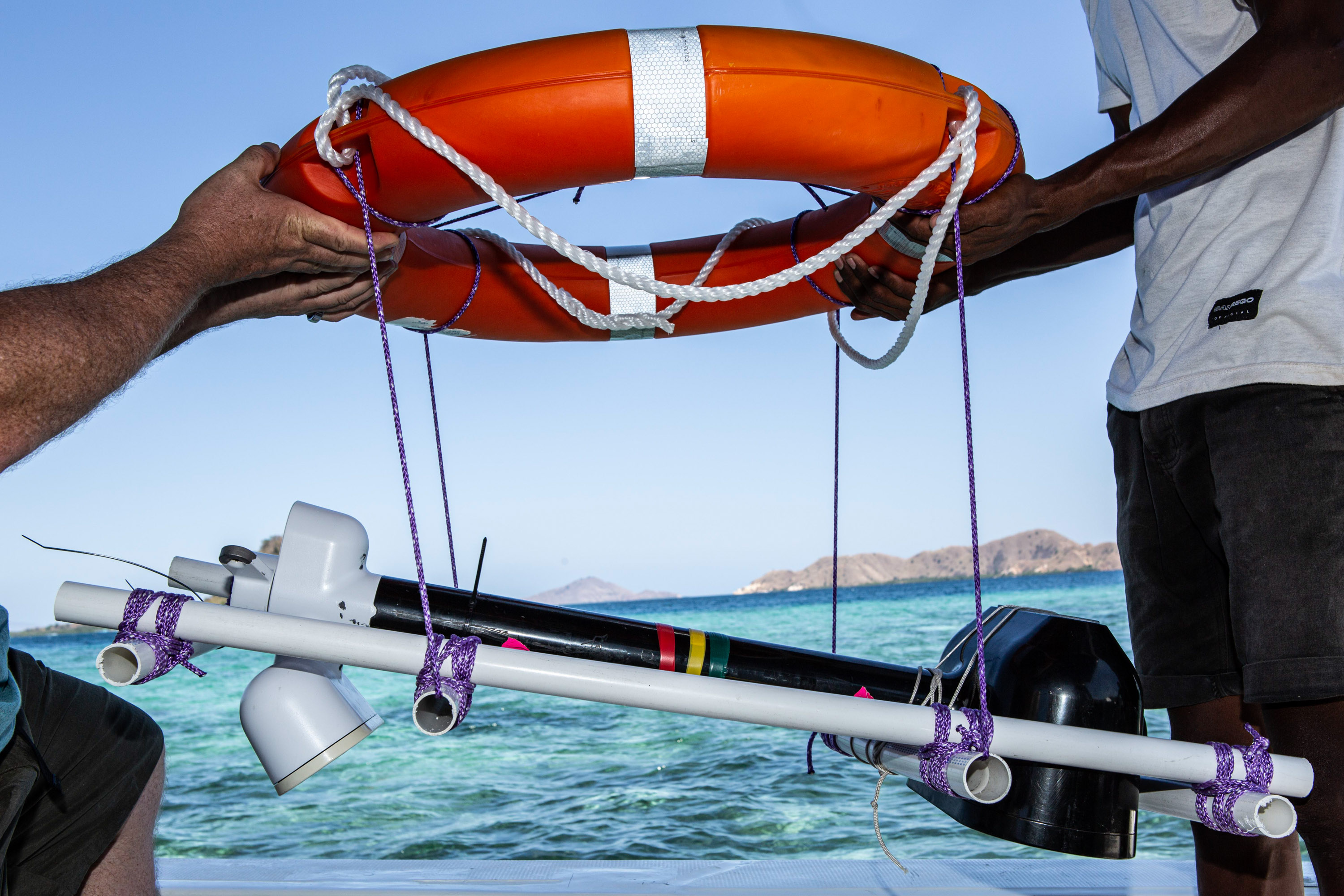 Tidal researchers test out a makeshift float for the camera system, whiled waiting on the Hammersled to arrive.
Tidal researchers test out a makeshift float for the camera system, whiled waiting on the Hammersled to arrive.photo : Agoes Rudianto
Back on the main island, the Australian scientists used makeshift ovens, including some created from hair dryers, to dry out the plant materials and sediments.
Then they ground them up and deposited them into hundreds of plastic bags, carefully marked to denote different locations and depths.
In the months to come, they’ll analyze the carbon content in each batch at their labs in Adelaide, determining the total amount in each plot.
“If our algorithm takes a look at the data we gathered before they took the core samples and comes up with the same answer, then we’ve got it,” says Terry Smith, a solutions engineer with Tidal.
Open questions
Not everyone, however, is convinced that seagrass is a particularly promising path for carbon removal, or one whose climate benefits we’ll be able to accurately assess.
Among the suite of approaches to carbon removal that the National Academies has explored in its studies, those focusing on coastal ecosystems rank near the bottom in terms of the potential to scale them up.
That’s largely because these ecosystems can only exist as narrow bands along shorelines, and there’s considerable competition with human activity.
“We need to do everything we can to preserve seagrass,” says Isaac Santos, a professor of marine biogeochemistry at the University of Gothenburg in Sweden, because of the valuable roles these plants play in protecting coasts, marine biodiversity, and more.
“But on the big question—Are they going to save us from climate change?—the answer is straightforward: No,” he says.
“They don’t have enough area to sequester enough carbon to make a big impact.”
Accurately determining the net carbon and climate impact from seagrass restoration is also problematic, as studies have highlighted.
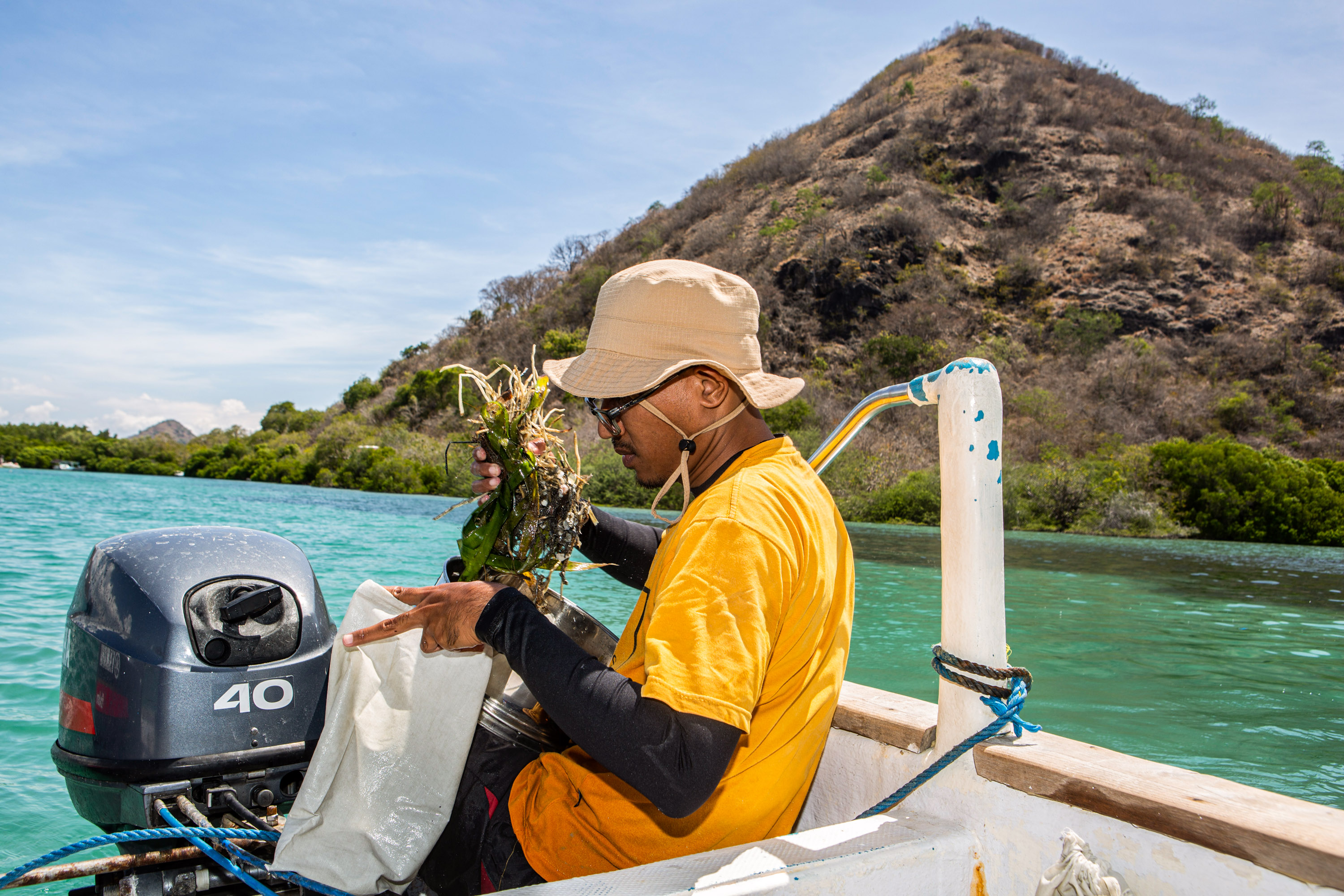 Wiyudha Pandu Laksana, an officer with the Kupang Water Conservation Area, puts a seagrass sample into a small bag near Waecicu Beach in Labuan Bajo, Indonesia.
Wiyudha Pandu Laksana, an officer with the Kupang Water Conservation Area, puts a seagrass sample into a small bag near Waecicu Beach in Labuan Bajo, Indonesia.photo : Agoes Rudianto
Carbon sequestration varies dramatically in these coastal meadows, depending on the location, the season, the mix of species, and how much gets gobbled up by fish and other marine creatures.
The carbon in seafloor sediments can also leak into the surrounding waters, where some is dissolved and effectively remains in the ocean for millennia, and some may escape back out into the atmosphere.
In addition, coastal ecosystems produce methane and nitrous oxide, potent greenhouse gases that would need to be factored into any estimate of overall climate impact.
Finally, the vast, vast majority of the carbon in seagrass beds is buried in the seafloor, not in the plant material that Tidal intends to measure.
“And we also know that the correlation between biomass and sediment carbon is not straight forward,” Santos said in an email.
“Hence, any approach based on biomass only will require all sorts of validations,” to ensure that it actually provides reliable estimates of stored carbon.
An essay in The Conversation late last month highlighted another concern: environmental justice.
The authors, Sonja Klinsky of Arizona State University and Terre Satterfield of the University of British Columbia, stressed that the local communities most affected by such projects should have considerable say in them.
Some coastal towns may not want to turn their active harbor back into, say, a salt marsh.
“Much of the global population lives near the ocean,” they wrote, and some interventions “might impinge on places that support jobs and communities” and provide significant amounts of food.
Unlocking the secrets
Addressing the scientific questions will require better understanding of coastline ecosystems.
CSIRO’s Steven says he hopes that Tidal’s technology will provide easier ways to conduct the necessary studies.
“It’s absolutely a challenge,” he says.
“But you’ve got to start somewhere.”
As for the environmental justice concerns, Tidal stresses that these nature-based approaches to carbon removal potentially provide multiple benefits to natural ecosystems and local communities.
They could, for instance, help to sustain fishery populations.
Tidal is also working with CSIRO to train local communities in Fiji and Indonesia, including university students, to help them participate directly in carbon markets.
“Ultimately, our vision is to provide these communities with tools to be able to manage, protect, and repopulate these local systems locally,” Davé said in an email.
So what’s next for Tidal?
It will still take months for the Australian team to complete its analysis of the seagrass and sediments.
Whatever they find, the teams plan to continue conducting field experiments to refine the models and algorithms and make sure they provide accurate carbon estimates across a variety of seagrass types in different regions and conditions.
For instance, Tidal may look to partner with other research groups focused on the Bahamas, another major seagrass region.
If it does ultimately work well, Tidal believes, its suite of tools could also support other ocean-based approaches to carbon removal, including growing more seaweed and restoring mangrove forests.
Davé says he can envision a variety of potential business models, including providing carbon measurement, reporting, and verification as a service to offsets registries or organizations carrying out restoration work.
They might also create autonomous robotic systems that plant seagrass with little human involvement.
Even if the systems don’t provide reliable enough carbon estimates, Tidal believes its efforts will still aid scientific efforts to understand crucial ocean ecosystems, and support international efforts to protect them.
That could include monitoring the well-being of coral reefs, which are gravely threatened by warming waters, Davé says.
It may not sound like a moonshot in the way that X originally conceived of the concept.
It’s certainly no space elevator.
But by building tools that a variety of organizations could use in a variety of ways to unlock the secrets of Earth’s critical and fragile ecosystems, Tidal may be demonstrating a new way to take on really hard problems.
Links :
No comments:
Post a Comment